Pietro Pala
Neuromorphic Drone Detection: an Event-RGB Multimodal Approach
Sep 24, 2024Abstract:In recent years, drone detection has quickly become a subject of extreme interest: the potential for fast-moving objects of contained dimensions to be used for malicious intents or even terrorist attacks has posed attention to the necessity for precise and resilient systems for detecting and identifying such elements. While extensive literature and works exist on object detection based on RGB data, it is also critical to recognize the limits of such modality when applied to UAVs detection. Detecting drones indeed poses several challenges such as fast-moving objects and scenes with a high dynamic range or, even worse, scarce illumination levels. Neuromorphic cameras, on the other hand, can retain precise and rich spatio-temporal information in situations that are challenging for RGB cameras. They are resilient to both high-speed moving objects and scarce illumination settings, while prone to suffer a rapid loss of information when the objects in the scene are static. In this context, we present a novel model for integrating both domains together, leveraging multimodal data to take advantage of the best of both worlds. To this end, we also release NeRDD (Neuromorphic-RGB Drone Detection), a novel spatio-temporally synchronized Event-RGB Drone detection dataset of more than 3.5 hours of multimodal annotated recordings.
Addressing Limitations of State-Aware Imitation Learning for Autonomous Driving
Oct 31, 2023Abstract:Conditional Imitation learning is a common and effective approach to train autonomous driving agents. However, two issues limit the full potential of this approach: (i) the inertia problem, a special case of causal confusion where the agent mistakenly correlates low speed with no acceleration, and (ii) low correlation between offline and online performance due to the accumulation of small errors that brings the agent in a previously unseen state. Both issues are critical for state-aware models, yet informing the driving agent of its internal state as well as the state of the environment is of crucial importance. In this paper we propose a multi-task learning agent based on a multi-stage vision transformer with state token propagation. We feed the state of the vehicle along with the representation of the environment as a special token of the transformer and propagate it throughout the network. This allows us to tackle the aforementioned issues from different angles: guiding the driving policy with learned stop/go information, performing data augmentation directly on the state of the vehicle and visually explaining the model's decisions. We report a drastic decrease in inertia and a high correlation between offline and online metrics.
Automatic Estimation of Self-Reported Pain by Trajectory Analysis in the Manifold of Fixed Rank Positive Semi-Definite Matrices
Sep 17, 2022



Abstract:We propose an automatic method to estimate self-reported pain based on facial landmarks extracted from videos. For each video sequence, we decompose the face into four different regions and the pain intensity is measured by modeling the dynamics of facial movement using the landmarks of these regions. A formulation based on Gram matrices is used for representing the trajectory of landmarks on the Riemannian manifold of symmetric positive semi-definite matrices of fixed rank. A curve fitting algorithm is used to smooth the trajectories and temporal alignment is performed to compute the similarity between the trajectories on the manifold. A Support Vector Regression classifier is then trained to encode extracted trajectories into pain intensity levels consistent with self-reported pain intensity measurement. Finally, a late fusion of the estimation for each region is performed to obtain the final predicted pain level. The proposed approach is evaluated on two publicly available datasets, the UNBCMcMaster Shoulder Pain Archive and the Biovid Heat Pain dataset. We compared our method to the state-of-the-art on both datasets using different testing protocols, showing the competitiveness of the proposed approach.
Modelling the Statistics of Cyclic Activities by Trajectory Analysis on the Manifold of Positive-Semi-Definite Matrices
Jun 24, 2020


Abstract:In this paper, a model is presented to extract statistical summaries to characterize the repetition of a cyclic body action, for instance a gym exercise, for the purpose of checking the compliance of the observed action to a template one and highlighting the parts of the action that are not correctly executed (if any). The proposed system relies on a Riemannian metric to compute the distance between two poses in such a way that the geometry of the manifold where the pose descriptors lie is preserved; a model to detect the begin and end of each cycle; a model to temporally align the poses of different cycles so as to accurately estimate the \emph{cross-sectional} mean and variance of poses across different cycles. The proposed model is demonstrated using gym videos taken from the Internet.
Automatic Estimation of Self-Reported Pain by Interpretable Representations of Motion Dynamics
Jun 24, 2020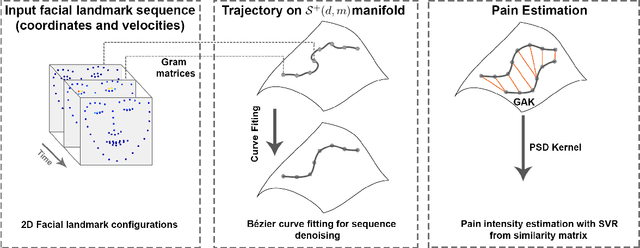
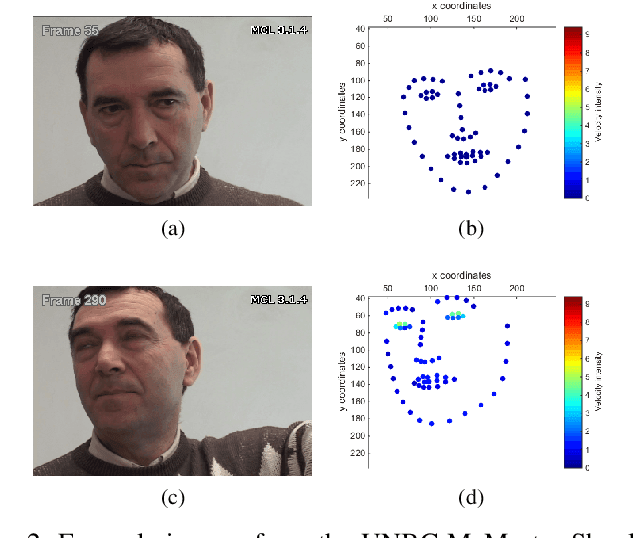
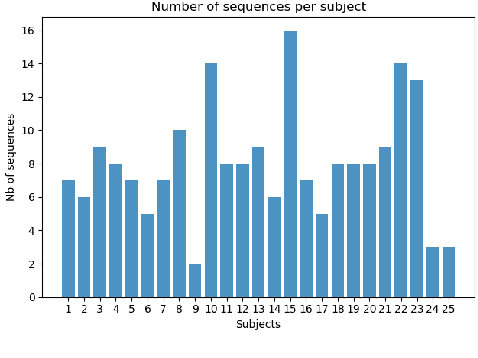
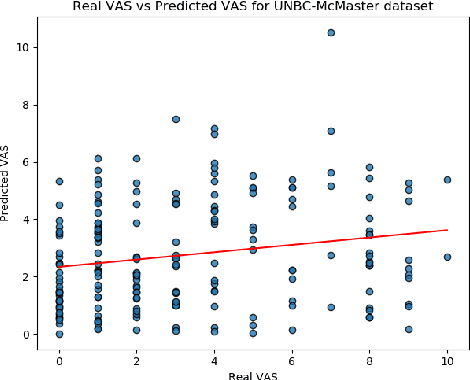
Abstract:We propose an automatic method for pain intensity measurement from video. For each video, pain intensity was measured using the dynamics of facial movement using 66 facial points. Gram matrices formulation was used for facial points trajectory representations on the Riemannian manifold of symmetric positive semi-definite matrices of fixed rank. Curve fitting and temporal alignment were then used to smooth the extracted trajectories. A Support Vector Regression model was then trained to encode the extracted trajectories into ten pain intensity levels consistent with the Visual Analogue Scale for pain intensity measurement. The proposed approach was evaluated using the UNBC McMaster Shoulder Pain Archive and was compared to the state-of-the-art on the same data. Using both 5-fold cross-validation and leave-one-subject-out cross-validation, our results are competitive with respect to state-of-the-art methods.
Building a Heterogeneous, Large Scale Morphable Face Model
Jun 06, 2020



Abstract:3D Morphable Models (3DMMs) are powerful statistical tools for representing and modeling 3D faces. To build a 3DMM, a training set of fully registered face scans is required, and its modeling capabilities directly depend on the variability contained in the training data. Thus, accurately establishing a dense point-to-point correspondence across heterogeneous scans with sufficient diversity in terms of identities, ethnicities, or expressions becomes essential. In this manuscript, we present an approach that leverages a 3DMM to transfer its dense semantic annotation across a large set of heterogeneous 3D faces, establishing a dense correspondence between them. To this aim, we propose a novel formulation to learn a set of sparse deformation components with local support on the face that, together with an original non-rigid deformation algorithm, allow precisely fitting the 3DMM to arbitrary faces and transfer its semantic annotation. We experimented our approach on three large and diverse datasets, showing it can effectively generalize to very different samples and accurately establish a dense correspondence even in presence of complex facial expressions or unseen deformations. As main outcome of this work, we build a heterogeneous, large-scale 3DMM from more than 9,000 fully registered scans obtained joining the three datasets together.
Explaining Autonomous Driving by Learning End-to-End Visual Attention
Jun 05, 2020



Abstract:Current deep learning based autonomous driving approaches yield impressive results also leading to in-production deployment in certain controlled scenarios. One of the most popular and fascinating approaches relies on learning vehicle controls directly from data perceived by sensors. This end-to-end learning paradigm can be applied both in classical supervised settings and using reinforcement learning. Nonetheless the main drawback of this approach as also in other learning problems is the lack of explainability. Indeed, a deep network will act as a black-box outputting predictions depending on previously seen driving patterns without giving any feedback on why such decisions were taken. While to obtain optimal performance it is not critical to obtain explainable outputs from a learned agent, especially in such a safety critical field, it is of paramount importance to understand how the network behaves. This is particularly relevant to interpret failures of such systems. In this work we propose to train an imitation learning based agent equipped with an attention model. The attention model allows us to understand what part of the image has been deemed most important. Interestingly, the use of attention also leads to superior performance in a standard benchmark using the CARLA driving simulator.
Fitting, Comparison, and Alignment of Trajectories on Positive Semi-Definite Matrices with Application to Action Recognition
Sep 09, 2019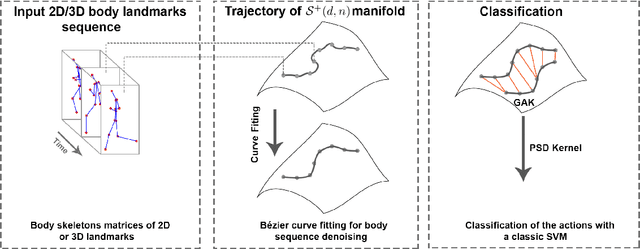

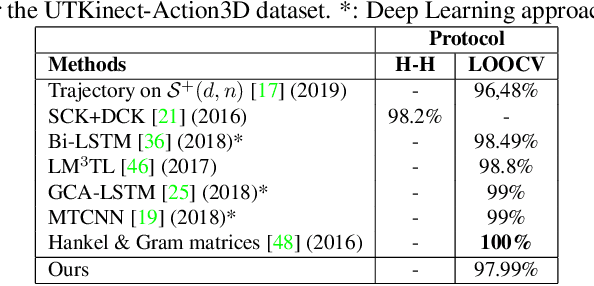

Abstract:In this paper, we tackle the problem of action recognition using body skeletons extracted from video sequences. Our approach lies in the continuity of recent works representing video frames by Gramian matrices that describe a trajectory on the Riemannian manifold of positive-semidefinite matrices of fixed rank. In comparison with previous works, the manifold of fixed-rank positive-semidefinite matrices is here endowed with a different metric, and we resort to different algorithms for the curve fitting and temporal alignment steps. We evaluated our approach on three publicly available datasets (UTKinect-Action3D, KTH-Action and UAV-Gesture). The results of the proposed approach are competitive with respect to state-of-the-art methods, while only involving body skeletons.
Emotion Recognition by Body Movement Representation on the Manifold of Symmetric Positive Definite Matrices
Jul 22, 2017



Abstract:Emotion recognition is attracting great interest for its potential application in a multitude of real-life situations. Much of the Computer Vision research in this field has focused on relating emotions to facial expressions, with investigations rarely including more than upper body. In this work, we propose a new scenario, for which emotional states are related to 3D dynamics of the whole body motion. To address the complexity of human body movement, we used covariance descriptors of the sequence of the 3D skeleton joints, and represented them in the non-linear Riemannian manifold of Symmetric Positive Definite matrices. In doing so, we exploited geodesic distances and geometric means on the manifold to perform emotion classification. Using sequences of spontaneous walking under the five primary emotional states, we report a method that succeeded in classifying the different emotions, with comparable performance to those observed in a human-based force-choice classification task.
 Add to Chrome
Add to Chrome Add to Firefox
Add to Firefox Add to Edge
Add to Edge